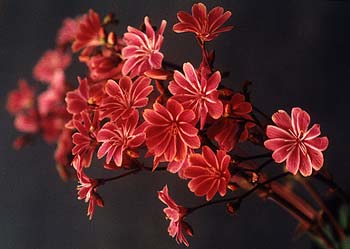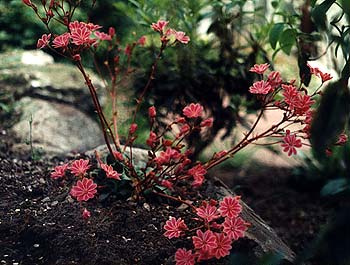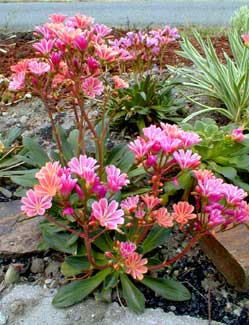 'Siskiyou Pink' Lewisia
'Siskiyou Pink' Lewisia
"To create a little flower is the labor of ages."
-William Blake
(1757-1827)
(1757-1827)
The first photograph shows the bright pink blooms of one of the Northwest's most beautiful native alpine wildflowers, Siskiyou Bitterroot (Lewisia cotyledon ssp cotyledon).
The second photo shows the same plant in its entirety, its leaves hugging the ground so closely they're hard to see from the side, it's many flowers raised high on branching fountains of stems. These were May photos from 2001.
The third photo might be the same plant a couple years after it was transplanted to a lewisia garden, or it's another pink-flowering specimen, photographed at the end of June 2004.
 Lewisia has a range from British Columbia into northern California, inland to the Rockies, but it is found most especially through the Klamath range of northern California & southern Oregon, where it experiences very little rainfall.
Lewisia has a range from British Columbia into northern California, inland to the Rockies, but it is found most especially through the Klamath range of northern California & southern Oregon, where it experiences very little rainfall.Though it is not as yet an endangered plant in the wild, there is some worry about its future, for its range is narrow & it has already vanished from many areas where it was once found. For this reason it is on the federal watchlist as a "species of concern" & it could well become endangered in the future. Its greatest enemy is illegal plant collecting.
There are now several gardened varieties & several specialty grower that propogate them from seeds & have produced spectactular nursery strains. So the wild populations need not be molested in order for gardeners to acquire all the lewisias our greedy hearts desire. So when you encounter them while visiting the Shasta, Klamath, or Siskiyou national parks, don't dig them up or pick their blossoms!
 Lewisias tolerate partial sun but prefer full sun. The one shown in the first two photos is planted in a sunny rock garden near a rocky ledge for fullest drainage. In our garden it has evergreen foliage, but in the colder areas (& it can be gardened in USDA zones 3 through 8), as well as in zones too warm for its comfort, it will be deciduous, dying back in summer.
Lewisias tolerate partial sun but prefer full sun. The one shown in the first two photos is planted in a sunny rock garden near a rocky ledge for fullest drainage. In our garden it has evergreen foliage, but in the colder areas (& it can be gardened in USDA zones 3 through 8), as well as in zones too warm for its comfort, it will be deciduous, dying back in summer.Lewisias prefer stony ground & rocky crevices; by growing from crevices it can keep its thick roots cool while holding its leaves & blossoms to bright sun. It is a little delicate in the garden only if it stays at all moist, as without sufficient drainage it will almost certainly rot in winter.
Our Lewisia collection is along a raised stone ledged ehere they get very sharp drainage, but another trick would be to build a gritty soil hill for them. But Lewisias do also prefer acidic soil conditions difficult to achieve without adding so much organic matter that it risks being left soggy, thus conifer needles might be better than regular compost or pete.
A mixture of soil, pea-gravel, & good compost, on a sharp slope, should take care of any risk of excess moisture, resulting in hardy easy low-mainteance plants that bloom like crazy. Another recommendation for them is to place them outside the drip-line of larger shrubs, so that rainwater will not still be dripping on them after rainfall stops. But some of ours do have overhanging shrubs without ill effect, so long as they get a full portion of sunlight.
We strive for careful placement in ultra-sharp-drainage locations, but otherwise don't baby our lewisias in the least, & they do excellently.
Lewisia cotyledon 'Rondo'